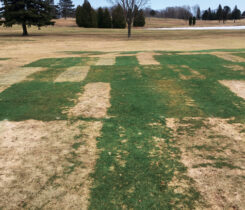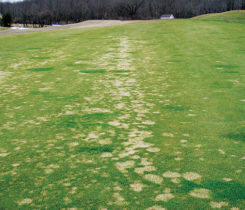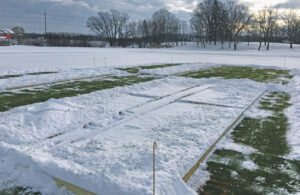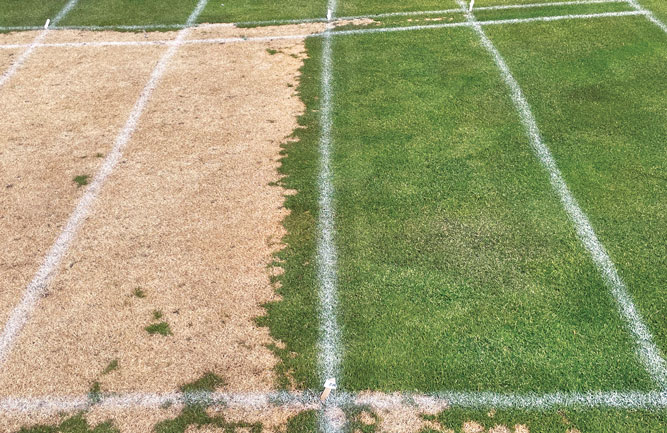Beat the summer heat, plan for snow mold
The dog days of summer are upon us, and it seems a little odd to be thinking about snow mold when you can’t stop sweating. Alas, Mother Nature relentlessly bulldozes onto the next season whether we’re ready or not. And to make sure we in the turf industry are ready for winter, it’s time for many of us to begin preparations to protect our turf from snow mold.
Those in temperate climates with significant snowfall know just how important snow mold diseases can be. It doesn’t matter whether it’s gray snow mold (Typhula incarnata) in places with snow cover greater than 60 continuous days; speckled snow mold (Typhula ishikariensis) in areas with snow cover greater than 90 days; or even Microdochium patch (Microdochium nivale) in cool and wet conditions; snow mold can be a devastating disease for turfgrass managers (Figures 1, 2, and 3).
Snow mold diseases are particularly important diseases to manage because you usually only get one shot at it. It’s one thing if you cut back on a dollar spot or brown patch management program, for if the disease breaks through you can curatively apply a fungicide and usually be back to normal in two weeks. Not so with snow mold.
If money is tight and you cut back on your snow mold management program after hearing forecasts of a mild winter, but instead receive a shellacking from Old Man Winter, well then you’re pretty much buried as deep as your turf is under snow. To add insult to injury, snow mold diseases can be particularly damaging to a golf course facility’s bottom line for two primary reasons.
First, the symptoms occur in the spring as golfers are at their most rabid to get out of the house and play golf. Second, if a cool spring persists that prevents rapid turf recovery, snow mold damage can be observed well into June. That can send golfers scrambling to neighboring courses for weeks or even months, drive down revenues at your course, and may have you polishing up your resume.
Fortunately, there are a multitude of options for effectively and affordably managing snow molds. But rather unfortunately, there are so many options that choosing the right one can be overwhelming. In a search for clarity, many superintendents will contact me for recommendations, though I always disappoint them with my answer: “It depends.”
“Well what does it depend on?” they often respond. The variation in disease pressure, course expectations, and financial capacity between courses renders an effective fungicide recommendation impossible without further information. The fungicide program I recommend for a private country club in Minneapolis is not likely to be the same program I recommend for a 9-hole municipal golf course in northern Wisconsin.
What does the research say?
Even after receiving all the pertinent information, it’s difficult to recommend a single fungicide for snow mold control because there are many effective options. One place to turn for help is university research, which is an independent means for determining what products are going to be effective. Several different universities across the country conduct fungicide research on snow mold, and here at the University of Wisconsin we have conducted snow mold fungicide efficacy trials at golf courses in Wisconsin, Minnesota and the Upper Peninsula of Michigan for years. The full list of all of our snow mold efficacy reports over the years, along with treatment pictures, can be found on the Research page of the Turfgrass Diagnostic Lab’s website.
When looking at our trial results over the years the treatments generally can be separated into three groups: (1) those treatments that manage snow mold extremely well even under heavy disease pressures; (2) those treatments that significantly reduce snow mold severity but oftentimes allow some disease to develop; and (3) those that do not effectively manage snow mold.
As evidenced in research conducted during the winters of 2010-2011 (Figure 4) and 2012-2013 (Figure 5), those treatments most effective at managing snow mold often contain three or even four active ingredients. These active ingredients often are a mixture of different physical modes of action (contact, penetrant, etc.) and chemical modes of action (strobilurin, DMI, etc.). This mix provides the best opportunity for your treatment to survive exposure to the harsh winter elements over a period of two, three or four months or longer.
Which treatments have proven to be the most effective under heavy snow mold pressure? Based only on our own research here at Wisconsin, products that have consistently performed well over a number of years under heavy pressure include Instrata (chlorothalonil+propiconazole+fludioxonil), Interface (iprodione+trifloxystrobin) + Triton FLO(triticonazole), Insignia SC(pyraclostrobin) + Trinity (triticonazole), Torque (tebuconazole) + 26/36 (iprodione+thiophante-methyl), and Quali-Pro TM/C (chlorothalonil+thiophanate-methyl) + QP Ipro (iprodione) + QP Propiconazole (propiconazole). You will probably notice that each one of these treatments includes at least three active ingredients, and some contain four. You will also probably notice that Syngenta, BASF, Bayer, NuFarm, and Quali-Pro are all represented in this list. That is not coincidental; each company has treatments that can effectively manage snow mold. How do you choose among these, you may ask? That will likely depend on the program’s cost and who you’re most comfortable working with. But the point is clear: You have options when choosing an effective snow mold fungicide.
Times are tight, are there any lower-cost options?
While the products listed above are certainly effective, they also can be costly. That is especially true when considering protecting acres of fairways. Based on an analysis I completed in 2011, protecting 30 acres of fairways with the treatments listed in the previous section can cost anywhere from $8,500 to over $15,000.
But what if your course doesn’t require disease-free fairways every spring? Or what if snow mold pressure at your location is generally pretty light? Are there lower cost options that may not completely control snow mold but still provide some level of protection?
Fortunately, the answer is yes. Using the results obtained from our research over the years, there are several options for affordable snow mold reduction (Figure 6). All six of the treatments listed in Figure 6 were below $10,000 for 30 acres of coverage in 2011 prices. Torque and Trinity were just more than $3,000 for 30 acres, and Turfcide 400(PCNB) was closer to $1,000. It’s important to note that fungicide prices vary considerably due to a number of factors and that these prices are from 2011. But it still gives a general picture of affordable yet effective options. It’s also important to note that these treatments aren’t likely to give you complete snow mold control.
All the treatments shown in Figure 6 reduced snow mold to less than 10 percent, an acceptable level on many fairways. However, if you’re looking for much less than 10 percent snow mold control, I would recommend a more diverse mixture of compounds similar to those listed in Figures 4 or 5. It’s also important to note that this analysis was only done on treatments that were included in our research at Wisconsin, and there are several other compounds (not to mention generic fungicides) not included in our research that can provide an affordable reduction in snow mold severity at your course.
The intangibles
It should be pretty clear by now that options for effective snow mold management are plentiful. That reality has led superintendents to look at aspects in addition to disease control to help them make their decisions. Since many products are priced competitively, the other intangible that can help sway a purchaser’s decision is turf color. That is certainly nothing new to the turf fungicide market, as fungicides promoting improved turf color, health and stress tolerance are heavily marketed for summer fungicide applications. More recently, however, superintendents have been looking toward their snow mold fungicide applications to improve the color of the golf course coming out of snow melt the following spring.
Bayer’s Stressgard pigments long have been a part of fungicides geared toward summer diseases but are now also included in products such as Interface that are primarily intended for snow mold. Other pigments such as Foursome by Quali-Pro and PAR by Harrell’s also have been included in snow mold research here at Wisconsin the past few years, and the turf is significantly greener the following spring. Civitas (mineral oil), which includes the green pigment Harmonizer, has not provided acceptable snow mold control in most of our trials at Wisconsin but has provided exceptional green color the following spring (Figure 7). This green color fades rapidly as the turf comes out of dormancy, but superintendents looking for any advantage they can get in difficult early spring conditions may find the brief green-up beneficial.
The final word
If options are what you crave in life, then choosing a snow mold fungicide program should leave you drooling. Too many effective options exist for me to list just a few, and what may work well for one facility may not quite fit with another facility for a number of reasons. The best recommendation I can give is to use the research provided by university efficacy trials to determine what products are effective in conditions similar to yours. Take these products and discuss pricing and other intangibles with a sales or technical representative you’re comfortable with, and come up with a plan for effective and affordable management of snow mold at your course. Then sit back and rest easy for the winter…unless ice starts to form.
Author’s note: Listing of specific products in this article is based on research conducted at the University of Wisconsin and is not intended to be an endorsement of the product or of the manufacturer.
Paul Koch, Ph.D., is a research scientist at the University of Wisconsin-Madison. Contact him at plkoch@wisc.edu.
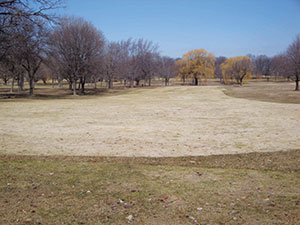
Figure 1: Gray snow mold, caused by Typhula incarnata, can decimate turf under snow cover for 60 days or more. Note the sharp line delineating between sprayed and non-sprayed turf at this course in Wisconsin. Photo courtesy Paul Koch, Ph.D.
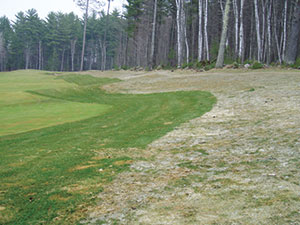
Figure 2: Speckled snow mold, caused by Typhula ishikariensis, causes severe damage in areas with snow cover greater than 90 consecutive days. At this course in Michigan’s Upper Peninsula, where disease pressure is extreme, a “clean up” fungicide pass is made to protect the rough closest to the fairway while anything unsprayed is severely infected. Photo courtesy Paul Koch, Ph.D.
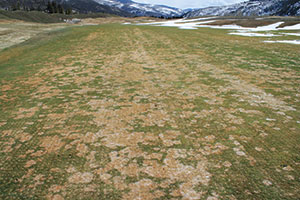
Figure 3: Microdochium patch, also called pink snow mold, doesn’t actually need snow cover to develop and will develop any time conditions are cool and wet. But the most severe symptoms usually develop following snow cover on unfrozen ground, as evidenced at this course in the Rocky Mountain West. Photo courtesy Paul Koch, Ph.D.
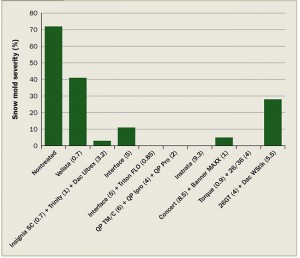
Figure 4: Comparison of a select number of treatments for speckled snow mold management at Sentryworld GC in Stevens Point, WI in the winter of 2010-2011. Fungicide rate in fluid ounces per 1,000 ft2 is in parentheses. Go here for the full trial results Photo courtesy Paul Koch, Ph.D.
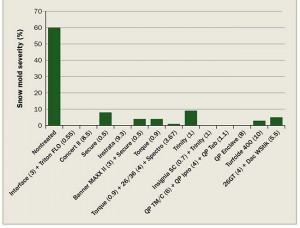
Figure 5: Comparison of a select number of treatments for speckled snow mold management at Wawonowin CC in Champion, MI in the winter of 2012-2013. Fungicide rate in fluid ounces per 1,000 ft2 is in parentheses. Go here for the full trial results. Photo courtesy Paul Koch, Ph.D.
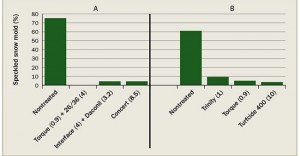
Figure 6: Efficacy of lower-cost options for control of speckled snow mold (Typhula ishikariensis) at (A) Sentryworld GC in Stevens Point, WI in 2010-2011 and (B) Wawonowin CC in Champion, MI in 2012-2013. Fungicide rate in fluid ounces per 1,000 ft2 is in parentheses. Photo courtesy Paul Koch, Ph.D.
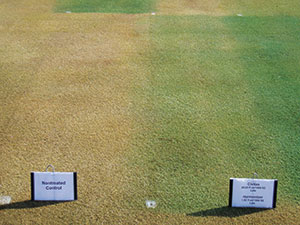
Figure 7: Civitas combined with Harmonizer, in addition to several other turf pigments and pigmented turf fungicides, applied in the fall can produce dramatically “greener” turf the following spring compared to non-treated turf. This photo was taken five months after the application on March 15th, 2012, in Madison, WI. Photo courtesy Paul Koch, Ph.D.









